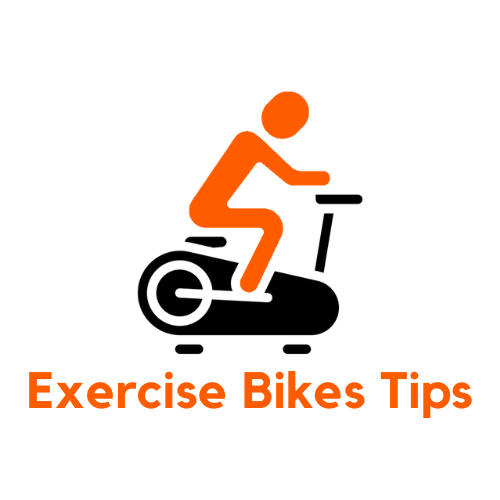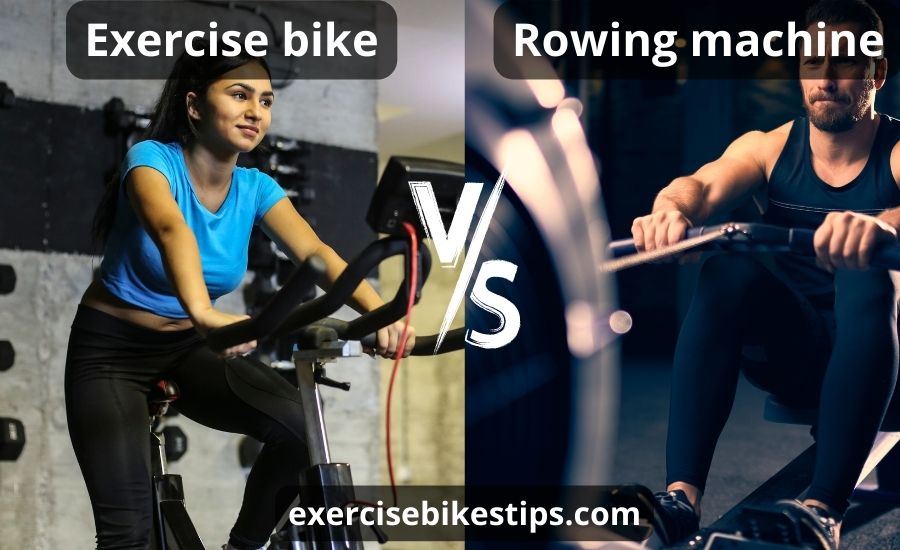Exercise bike vs. Rowing machine? When it comes to choosing the right cardio workout equipment for your home gym, two popular options of exercise equipment often come to mind: the exercise bike and the rowing machine.
Both of these exercise machines offer effective cardio workouts, but they differ in terms of their mechanics, benefits, and overall user experience.
In this article, we will explore the key features and advantages of a rowing machine vs. exercise bike to help you make an informed decision about which exercise machine best suits your fitness goals and preferences.

Rowing machine vs. exercise bike: key features
Let’s discuss the main details of each exercise machine.
Exercise bike
Design and functionality: The stationary exercise bike, also known as a stationary bike or stationary cycle, mimics the motion of cycling. It typically consists of a seat, pedals, and handlebars.
There are two main types of exercise bikes: upright bikes and recumbent bikes. Upright bikes simulate outdoor cycling, while recumbent bikes provide a more relaxed seated position with a backrest.
Resistance mechanisms: Stationary bikes offer various resistance mechanisms such as friction, magnetic, or air resistance.
Friction resistance involves a brake pad pressing against a flywheel, while magnetic resistance uses magnets to control the level of difficulty.
Air resistance utilizes a fan blade that spins as you pedal, generating resistance. You use your body weight to build leg muscles through a workout routine or lose weight thanks to cardiovascular exercise.
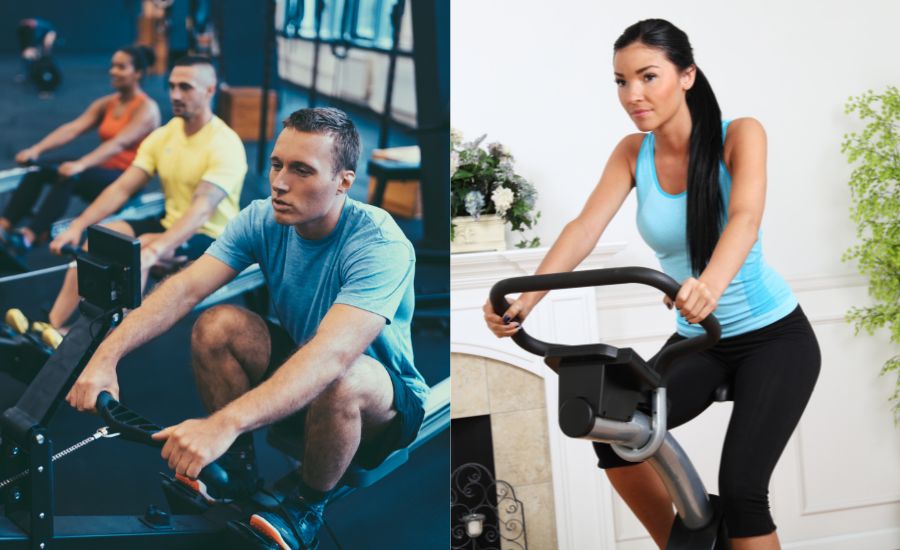
Rowing machine
Design and functionality: A rowing machine, also called an indoor rower, is designed to simulate the action of rowing a boat.
It consists of a seat, footrests, a handlebar, and a resistance mechanism. Rowing machines often use a flywheel and a chain or strap connected to the handlebar to create resistance.
Resistance mechanisms: Rowing machines typically employ one of four resistance mechanisms: air, water, magnetic, or hydraulic.
Air resistance is created by a flywheel with fan blades, while water resistance utilizes a tank filled with water and paddles. Magnetic resistance uses magnets to adjust the resistance level, and hydraulic resistance relies on hydraulic pistons.
Benefits and workout effectiveness
Here are some benefits for comparison.
Exercise bike
Cardiovascular conditioning: Using stationary bikes offers an excellent cardio workout that strengthens the heart and improves overall cardiovascular endurance.
The continuous pedaling motion raises the heart rate and increases blood flow, enhancing cardiovascular system health.
Lower impact on joints: Compared to many other cardio exercises, such as running or jumping, this cardio equipment is relatively low-impact.
This makes it an ideal choice for keeping proper form for individuals with joint pain or those recovering from lower body injuries.
Muscle engagement: Pedaling on a stationary exercise bike primarily targets the lower body muscles, including the quadriceps, hamstrings, calves, and glutes to achieve sufficient lower body stability.
However, by adjusting the resistance level and incorporating interval training or standing climbs, you can engage your core and upper body muscles as well.
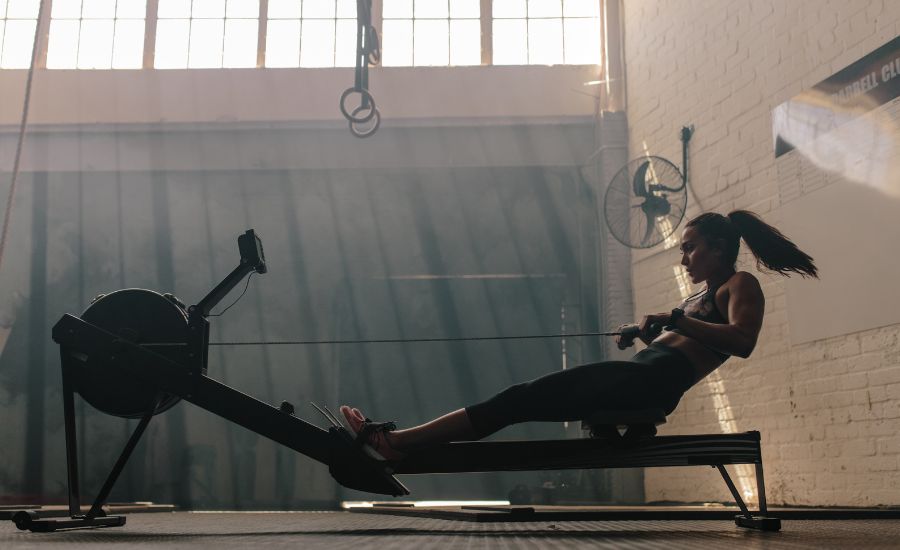
Rowing machine
Full-body workout: Rowing is often referred to as a full-body workout because it engages multiple muscle groups simultaneously in the lower and upper body.
The rowing motion involves the legs, core, arms, and back, providing an effective and efficient way to strengthen and tone your entire body with a full-body cardiovascular workout.
Low-impact and joint-friendly: Similar to the exercise bike, rowing machines offer a low-impact workout that puts minimal stress on your joints.
The smooth gliding motion and the support provided by the seat make it an excellent choice for individuals with joint issues or those seeking a low-impact exercise option.
Increased caloric burn: Rowing is a high-intensity, calorie-burning exercise.
It engages large muscle groups in the lower and upper body and elevates the heart rate, helping you burn a significant amount of calories in a relatively short period. This can be beneficial for weight loss or maintaining healthy body composition.

User experience and considerations
What else do you need to keep in mind?
Exercise bike
Comfort and accessibility: Exercise bikes provide a comfortable and accessible workout experience. Upright bikes mimic the feel of outdoor cycling and offer a more intense workout.
Recumbent bikes provide a reclined position with back support, making them suitable for individuals with back or balance issues.
Ease of use: Operating an exercise bike is straightforward, making it suitable for individuals of all fitness levels, including beginners. The adjustable resistance levels allow you to customize the intensity of your workout to match your fitness level and goals.
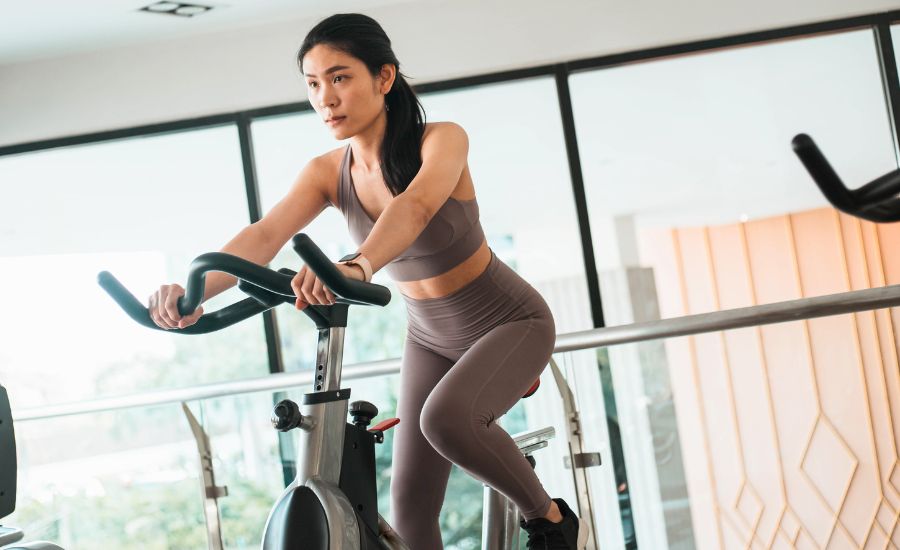
Rowing machine
Learning curve: Using a rowing machine may require some initial practice to master the proper rowing technique.
It involves coordinating the leg drive, body swing, and arm pull to maximize the effectiveness of each stroke. However, with proper guidance and practice, anyone can learn to row effectively.
Space and storage: Rowing machines typically have a larger footprint compared to exercise bikes, so they require more space. Additionally, some rowing machines can be folded or stored upright to save space when not in use.
Choosing the right equipment
When deciding, consider the following factors:
Fitness goals
Determine whether your primary goal is cardiovascular conditioning, weight loss, muscle toning, or a combination of these.
Both machines offer excellent cardiovascular workouts, but rowing machines provide a more comprehensive full-body workout.
Joint health
If you have joint issues or need a low-impact workout, both the exercise bike and rowing machine are suitable options. However, the rowing machine may be more beneficial as it engages multiple muscle groups while minimizing stress on the joints.
Space and budget for your home gym
Exercise bikes are generally more compact and budget-friendly compared to rowing machines, which can be larger and pricier.
Other options
You can also try any other workout machine, such as a spinning bike or ellipticals. Elliptical machines and spin bikes allow for more diversity of upper and lower body exercises in your routine.
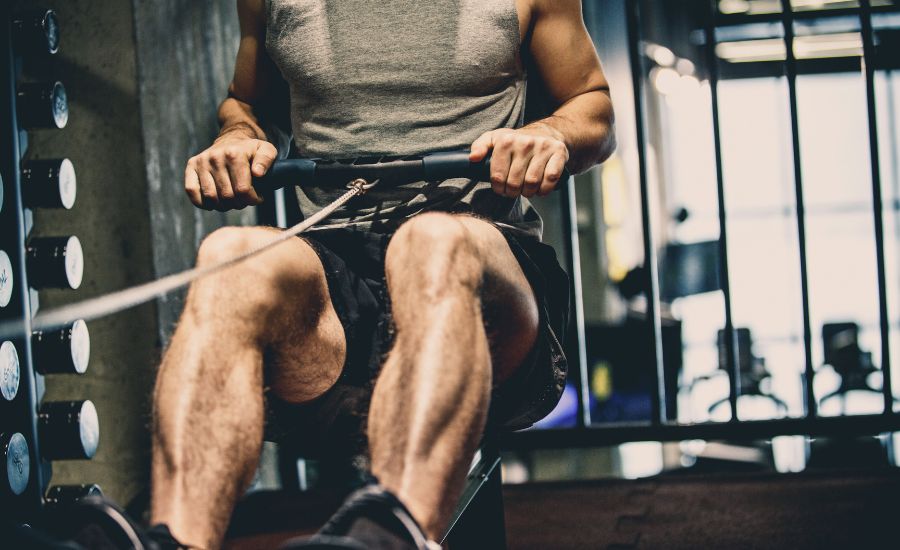
FAQ
If you have some questions left about the rowing machine vs. exercise bike, here are the answers to them.
Is a rowing machine better exercise than a stationary bike?
Both the rowing machine and the stationary bike offer effective cardiovascular workouts, but determining which one is better depends on individual preferences and fitness goals.
The rowing machine provides a comprehensive full-body workout, engaging multiple muscle groups simultaneously.
It targets the legs, core, arms, and back, making it an excellent choice for individuals looking for a total body workout. Rowing also burns a significant amount of calories, making it beneficial for weight loss and improving overall fitness.
On the other hand, the stationary bike primarily targets the lower body muscles, such as the quadriceps, hamstrings, calves, and glutes.
Is 20 minutes on a stationary bike enough?
The effectiveness of a 20-minute workout on a stationary bike depends on various factors, including the intensity of the exercise, the individual’s fitness level, and their specific goals.
For beginners or individuals with limited time, a 20-minute workout on a stationary bike can provide cardiovascular benefits and contribute to overall fitness. It can help improve heart health, increase endurance, and burn calories.
However, for individuals aiming for weight loss or significant fitness improvements, a 20-minute workout may not be sufficient on its own.
It’s generally recommended to engage in at least 150 minutes of moderate-intensity aerobic exercise or 75 minutes of vigorous-intensity aerobic exercise per week for overall health benefits.
If time is a constraint, incorporating high-intensity interval training (HIIT) into the 20-minute stationary bike workout can maximize its effectiveness. HIIT involves alternating between short bursts of intense exercise and periods of active recovery, making the workout more efficient and challenging.
Is rowing machine good for belly fat?
Using a rowing machine can contribute to overall fat loss, including reducing belly fat. Rowing is considered a high-intensity, calorie-burning exercise that engages multiple muscle groups, including the core.
To effectively target belly fat, it’s essential to combine regular rowing workouts with a well-rounded approach that includes a balanced diet, strength training, and other forms of exercise.
Spot reduction, which refers to losing fat from a specific area of the body, is not possible. Fat loss occurs throughout the body as a whole when there is a calorie deficit.
Rowing can be an effective component of a comprehensive fitness routine aimed at reducing body fat, including belly fat. It helps increase overall calorie expenditure, builds lean muscle, and improves cardiovascular fitness.
Is rowing a good substitute for cycling?
Rowing can be a good substitute for cycling, depending on individual preferences and goals. Both rowing and cycling provide excellent cardiovascular workouts and have their unique benefits.
Rowing offers a full-body workout, engaging multiple muscle groups simultaneously. It targets the legs, core, arms, and back, making it ideal for individuals looking to strengthen and tone their entire body. Rowing also provides a higher calorie burn compared to cycling due to the involvement of more muscle groups.
Cycling primarily targets the lower body muscles, such as the quadriceps, hamstrings, calves, and glutes. It offers a lower-impact workout and is a popular choice for individuals with joint issues or those who prefer a specific leg-focused exercise.
If you enjoy full-body engagement and variation in muscle involvement, rowing can be a good substitute for cycling. However, if you prefer a lower-impact exercise that focuses primarily on the lower body, cycling may be a better option. It ultimately comes down to personal preference and goals.
Conclusion
In conclusion, choosing between a rowing machine vs. exercise bike depends on your goals, preferences, and physical condition.
Both machines offer effective cardiovascular workouts, but the rowing machine provides a more comprehensive workout.
Consider factors such as comfort, accessibility, learning curve, and space requirements when making your decision. Ultimately, the best choice is the one that motivates you to stay consistent with your exercise routine and helps you achieve your fitness goals.
